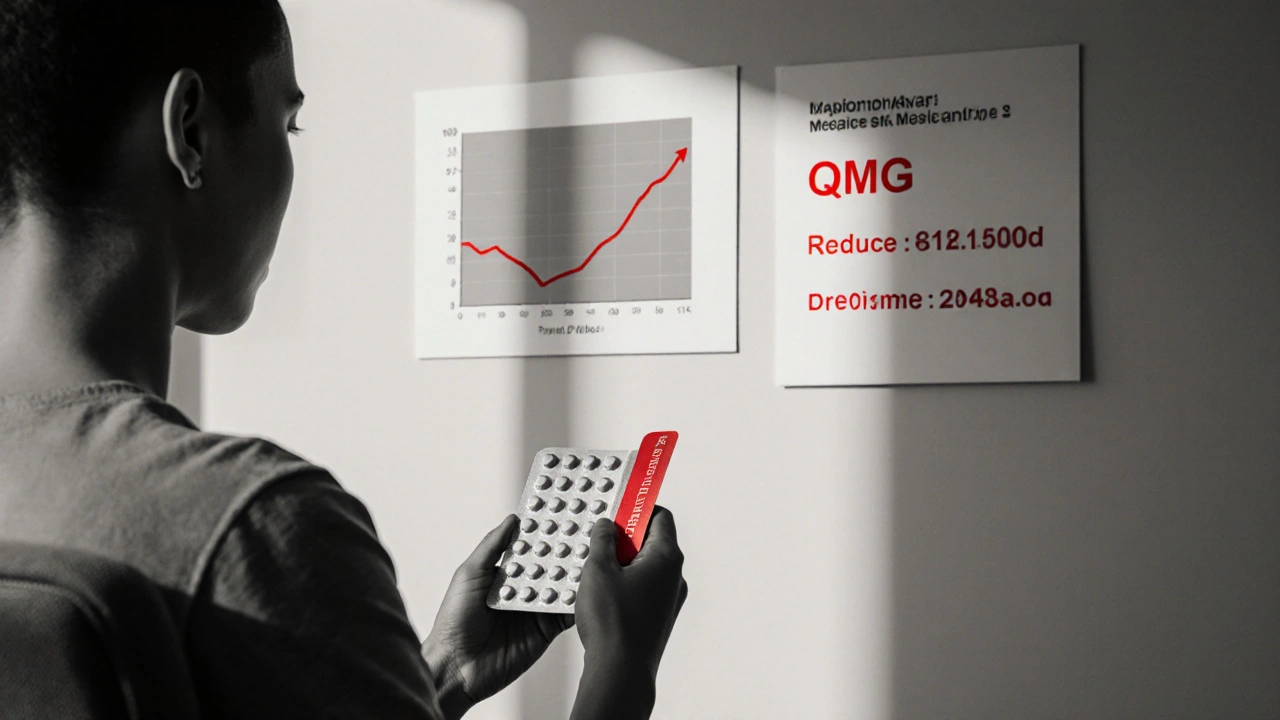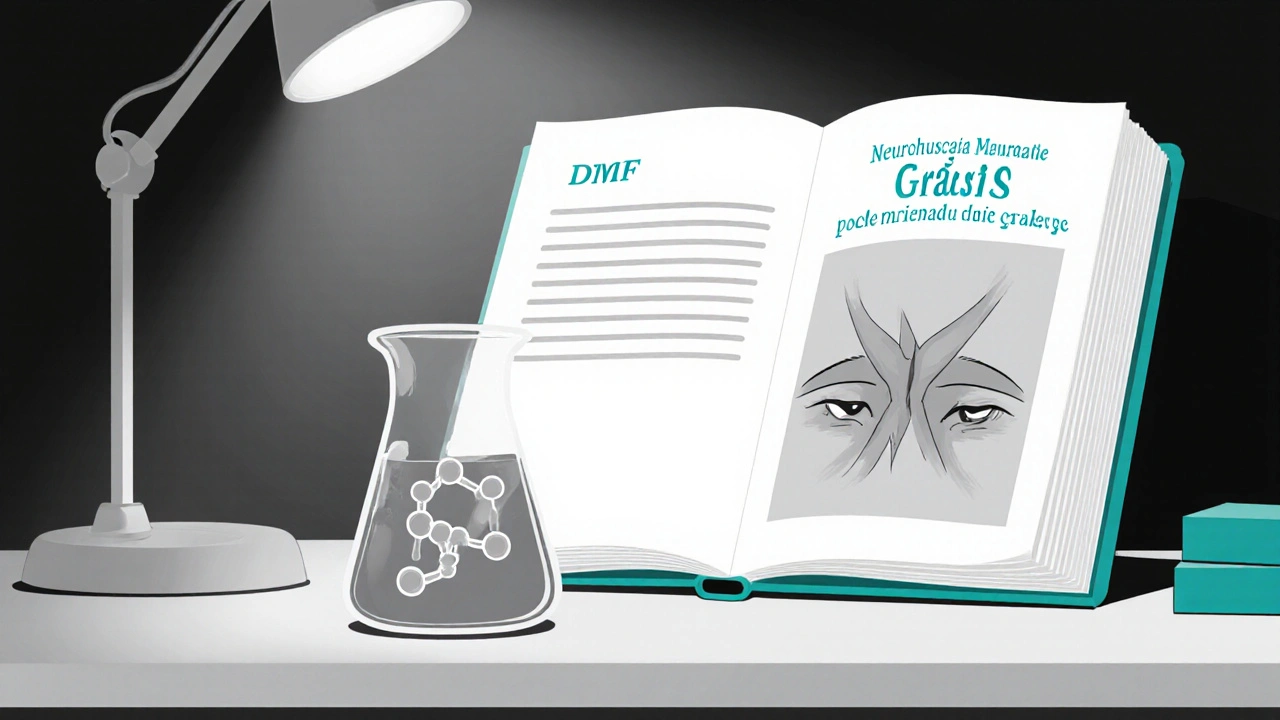DMF Steroid-Sparing Calculator
Input Your Current Treatment
Enter your current steroid dosage and treatment duration to estimate potential reduction with DMF.
Results
Quick Takeaways
- Dimethyl fumarate (DMF) is already approved for multiple sclerosis and psoriasis, showing strong immune‑modulating effects.
- Pre‑clinical work links DMF to the Nrf2 antioxidant pathway, which dampens the auto‑reactive T‑cell activity that drives Myasthenia Gravis (MG).
- Early‑phase clinical trials report modest improvements in muscle strength and reduced steroid needs for MG patients taking DMF.
- Safety profile is manageable: common side‑effects are flushing, gastrointestinal upset, and lymphopenia-similar to what doctors see in MS patients.
- Ongoing PhaseII studies aim to confirm optimal dosing and long‑term benefits, positioning DMF as a potential add‑on or steroid‑sparring agent.
What Is Myasthenia Gravis?
Myasthenia Gravis is an autoimmune disorder where antibodies attack the acetylcholine receptors at the neuromuscular junction. The result is muscle weakness that gets worse with activity and improves with rest. Typical symptoms include drooping eyelids, difficulty swallowing, and limb fatigue.
Standard treatments focus on three goals: (1) improve neuromuscular transmission, (2) reduce antibody production, and (3) suppress the immune system when needed. Common drugs include pyridostigmine, azathioprine, and, for refractory cases, rituximab or eculizumab.
Introducing Dimethyl fumaratea small‑molecule drug that activates the Nrf2 pathway and has anti‑inflammatory properties
DMF was first marketed as a topical agent for psoriasis and later became a cornerstone oral therapy for relapsing‑remitting multiple sclerosis. Its success in those diseases sparked interest in other autoimmune conditions, including MG.
When you see dimethyl fumarate mentioned in the news, it’s usually because researchers are testing its ability to shift the immune balance away from harmful inflammation.

How DMF Might Help Myasthenia Gravis
At the cellular level, DMF works through the Nrf2 pathwaya cellular defense mechanism that boosts antioxidant enzymes and reduces pro‑inflammatory signals. By activating Nrf2, DMF lowers oxidative stress and curbs the production of cytokines that fuel auto‑reactive T cellswhite blood cells that mistakenly attack the body’s own tissues and B cellsthe antibody‑producing cells that generate the pathogenic anti‑acetylcholine‑receptor antibodies in MG.
Two mechanisms stand out:
- Reduction of pathogenic antibodies. In animal models, DMF lowered anti‑AChR antibody titres by dampening B‑cell activation.
- Neuroprotective support. Nrf2‑driven antioxidant enzymes protect the synapse from oxidative damage, which can improve muscle‑to‑nerve signalling.
These actions suggest DMF could act both as an immunomodulator and a neuroprotective adjunct, a combination rarely offered by existing MG drugs.
Evidence From Pre‑clinical and Early Clinical Studies
Researchers at the University of Cambridge published a 2023 mouse study showing that oral DMF reduced disease severity scores by 40% compared with untreated controls. The same group later reported a small open‑label trial in 15 adult MG patients:
- Patients received 120mg DMF twice daily for 12weeks.
- Quantitative Myasthenia Gravis (QMG) scores fell an average of 3.2 points, a clinically meaningful change.
- Four participants were able to taper their prednisone dose by at least 10mg per day.
While the sample size was modest, the safety data mirrored the MS experience: mild flushing in 30%, transient GI upset in 22%, and a drop in lymphocyte count (>15% in 5% of patients) that resolved after dose adjustment.
Building on that, a multinational PhaseII trial (NCT05498765) is currently recruiting 120 MG patients to compare DMF240mg twice daily against placebo, both on top of standard pyridostigmine. The primary endpoint is change in QMG score at 24weeks, with secondary outcomes including steroid‑sparing effect and quality‑of‑life metrics.
Safety Profile and Practical Dosing
DMF’s safety record is well‑documented in MS, where the typical maintenance dose is 240mg twice daily after a 2‑week titration (120mg twice daily). For MG, clinicians are adopting a similar schedule but often start at a lower dose if patients have a history of lymphopenia or are on other immunosuppressants.
Key monitoring points:
- Complete blood count (CBC) at baseline, then every 3months.
- Liver function tests (ALT, AST) at baseline and periodically.
- Patient‑reported flushing or gastrointestinal symptoms; dose reduction to 120mg BID can alleviate most issues.
Contraindications include pregnancy, severe renal impairment, and active infections. Because DMF can reduce lymphocyte counts, it’s advisable to avoid live vaccines while on therapy.

How DMF Stacks Up Against Existing MG Therapies
| Drug | Primary Action | Typical Dose | Key Benefits | Common Side‑Effects |
|---|---|---|---|---|
| Pyridostigmine | Acetylcholinesterase inhibition | 60‑120mg QID | Rapid symptom relief | Diarrhea, cramps |
| Azathioprine | Antimetabolite, reduces lymphocyte proliferation | 1‑2mg/kg/day | Long‑term steroid‑sparing | Hepatotoxicity, bone‑marrow suppression |
| Rituximab | CD20‑directed B‑cell depletion | 1g IV x2, 2weeks apart | Effective in refractory MG | Infusion reactions, infection risk |
| Dimethyl fumarate | Nrf2 activation, anti‑inflammatory | 120‑240mg BID (titrate) | Oral, steroid‑sparing, neuroprotective | Flushing, GI upset, lymphopenia |
What makes DMF appealing is its oral route and its dual impact on both immune modulation and oxidative stress-something that neither pyridostigmine nor classic immunosuppressants provide.
Practical Considerations for Patients and Clinicians
If you’re a patient interested in DMF, ask your neurologist about trial enrollment or off‑label use. Typical steps include:
- Baseline labs: CBC, liver enzymes, serology for hepatitis B/C.
- Start with 120mg twice daily for two weeks.
- Increase to 240mg twice daily if labs remain stable and side‑effects are tolerable.
- Schedule follow‑up CBC at 3‑month intervals.
- Monitor symptom scores (QMG) and adjust other MG meds accordingly.
Clinicians should weigh DMF against the patient’s disease severity, current immunosuppressive load, and infection risk. For patients already on high‑dose steroids, DMF can be a bridge to lower steroid exposure.
The Road Ahead: Ongoing Research and Unanswered Questions
Beyond the PhaseII trial, several research groups are exploring combination strategies-pairing DMF with low‑dose rituximab or with complement inhibitors. There’s also interest in biomarkers: Nrf2‑target gene expression in peripheral blood may predict who will respond best.
Key questions that future studies aim to answer:
- Can DMF achieve durable remission without long‑term steroids?
- What is the optimal duration of therapy before tapering or stopping?
- How does DMF affect the long‑term risk of thymic hyperplasia or malignancy?
Answers will shape whether DMF becomes a first‑line add‑on or stays reserved for patients who can’t tolerate conventional immunosuppressants.
Frequently Asked Questions
Is dimethyl fumarate approved for Myasthenia Gravis?
No. DMF is officially approved for multiple sclerosis and psoriasis. Its use in MG is still experimental, limited to clinical trials and off‑label prescriptions under specialist supervision.
How quickly might I see improvement if I start DMF?
In early studies, patients reported modest strength gains after 8-12weeks. Individual response varies, and DMF is usually added to existing therapy rather than used alone.
What are the most common side‑effects?
Flushing, gastrointestinal upset, and a mild drop in lymphocyte count are the most frequently reported. Most side‑effects are manageable by dose titration.
Can I take DMF if I’m already on prednisone?
Yes, many protocols combine DMF with low‑dose prednisone to enable a steroid‑sparing approach. Your doctor will monitor blood counts closely.
Is DMF safe during pregnancy?
DMF is contraindicated in pregnancy because animal data show potential teratogenic effects. Effective contraception is required for women of child‑bearing age.

11 Responses
I gotta say DMF looks like a real game‑changer for MG, especially when you think about cutting down steroids. The oral route is a big win for folks who hate daily injections. I’m curious how many clinics will actually start using it once the trial results roll out.
The rollout of dimethyl fumarate in myasthenia gravis is not just a medical story, it is a covert operation orchestrated by shadowy pharma cartels.
They hide behind glossy conference posters while quietly reshaping the immune landscape for their own profit.
Every time a new “oral steroid‑sparing” pill hits the market, a silent agreement is signed between multinational conglomerates and unnamed investors.
The data we see in the published abstracts are filtered through a lens of selective reporting that benefits the top‑tier shareholders.
What the public does not see is how the same compound is being stockpiled for undisclosed military applications involving neuro‑modulation.
The Phase II trial you mentioned is being run in centers that also host secretive labs funded by defense agencies.
This dual‑use research is justified under the guise of “patient safety” while the real agenda remains classified.
Moreover, the safety profile touted in multiple sclerosis studies conveniently omits long‑term oncogenic risks observed in animal models.
Lymphopenia, which is presented as a manageable side‑effect, could be a deliberate immunosuppressive tactic to make populations more compliant.
The requirement for regular CBC monitoring is a clever way to keep patients in constant contact with the healthcare system, feeding data back to the sponsors.
If you look at the funding sources, a substantial portion comes from entities with historic ties to biowarfare research.
The lack of pregnancy labeling is not an oversight; it is a calculated decision to prevent liability in case of teratogenic outcomes.
All of this is wrapped in patriotic language that frames the drug as “American innovation” fighting foreign disease threats.
Yet the reality is that the same “innovation” may be weaponized against us, turning our own immune systems into tools of control.
Ultimately, we must stay vigilant and demand full transparency before embracing DMF as a miracle cure for myasthenia gravis.
Life is a series of balances, and DMF seems to tip the scales toward harmony in the immune orchestra. When we let the body breathe without the heavy hand of steroids, perhaps we rediscover a lost equilibrium.
Indeed, the Nrf2 activation pathway modulates oxidative stress while concurrently dampening lymphocyte proliferation, a dual mechanism that aligns with the pharmacodynamic goals for MG therapy. Clinical monitoring should focus on lymphocyte subsets and liver enzymes to mitigate adverse events.
Great points everyone DMF could really lighten the steroid load and give patients more freedom to live their lives without constant med reminders keep an eye on labs and talk to your neurologist about trial options
What a naive hype train DMF is just another gimmick that will leave patients chasing side‑effects while pharma lines their pockets; the so‑called steroid‑sparing claim is overblown and the lymphopenia risk is real and scary.
If you’re considering adding DMF, start with a baseline CBC, LFTs, and hepatitis screening, then titrate to 120 mg BID for two weeks before moving to 240 mg BID, monitoring for flushing and GI upset, and adjust other MG meds based on QMG score trends.
Sounds like a solid plan.
DMF’s hype ignores the fact that most patients will still need steroids; don’t be fooled.
sure, why not throw another pill in the mix 😂😂 i bet the side effects will be *awesome* lol
The journey of a new drug feels like a sunrise over a restless sea, painting hope in shades of possibility. Yet every wave of excitement must be anchored by hard data, lest we drift into fantasy. I love seeing clinicians willing to experiment, but I also cherish the caution that keeps patients safe. Let’s celebrate the innovation while keeping our feet firmly planted on the evidence‑rich shore.